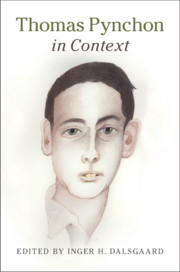Book contents
- Thomas Pynchon in Context
- Thomas Pynchon in Context
- Copyright page
- Contents
- Contributors
- Abbreviations
- Chronology
- Introduction
- Part I Times and Places
- Chapter 1 Biography
- Chapter 2 Letters and Juvenilia
- Chapter 3 Nonfiction
- Chapter 4 East Coast
- Chapter 5 West Coast
- Chapter 6 Europe and Asia
- Chapter 7 Africa and Latin America
- Chapter 8 Geographies and Mapping
- Chapter 9 The Eighteenth Century
- Chapter 10 The Nineteenth Century
- Chapter 11 The Twentieth Century
- Chapter 12 The Twenty-First Century
- Chapter 13 History and Metahistory
- Part II Culture, Politics, and Society
- Part III Approaches and Readings
- Further Reading
- Index
Chapter 3 - Nonfiction
from Part I - Times and Places
Published online by Cambridge University Press: 31 May 2019
- Thomas Pynchon in Context
- Thomas Pynchon in Context
- Copyright page
- Contents
- Contributors
- Abbreviations
- Chronology
- Introduction
- Part I Times and Places
- Chapter 1 Biography
- Chapter 2 Letters and Juvenilia
- Chapter 3 Nonfiction
- Chapter 4 East Coast
- Chapter 5 West Coast
- Chapter 6 Europe and Asia
- Chapter 7 Africa and Latin America
- Chapter 8 Geographies and Mapping
- Chapter 9 The Eighteenth Century
- Chapter 10 The Nineteenth Century
- Chapter 11 The Twentieth Century
- Chapter 12 The Twenty-First Century
- Chapter 13 History and Metahistory
- Part II Culture, Politics, and Society
- Part III Approaches and Readings
- Further Reading
- Index
Summary
Nonfiction prose accounts for more than half of Thomas Pynchon’s Wikipedia bibliography and has been organized into six categories: Technical Publications; Essays; Purported Interview; Letters; Reviews; and Introductions and Liner Notes. Among items listed are a brief article on missile airlift procedure from Aerospace Safety (1960), a disavowed interview with Playboy Japan (2001), liner notes (1995) to the indie record Nobody’s Cool (1996), and a short contribution to his son’s school newsletter (1999). Some items merely cite quotations appearing in other places, as with Jules Siegel’s 228-word quotation from a piece of personal correspondence. Some items are brief: Pynchon’s contribution to “Words for Salman Rushdie” (1989) turns out to be a mere sixty-eight words for Salman Rushdie. At least three items appear with caveats to the tune of “this could have been Pynchon but wasn’t.” Though we might chalk up this odd accounting to idiosyncratic editors, Wikipedia’s is a fairly comprehensive listing of Pynchon’s nonfiction, which remains uncollected. The entirety of Pynchon’s nonfiction oeuvre – excluding letters, known pranks, and pieces of unverified authorship – adds up to about 40,000 words, or not quite one-eighth the length of Gravity’s Rainbow (1973).
- Type
- Chapter
- Information
- Thomas Pynchon in Context , pp. 23 - 30Publisher: Cambridge University PressPrint publication year: 2019



